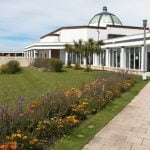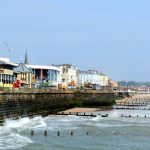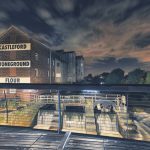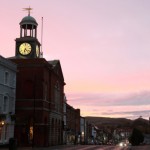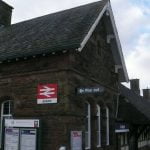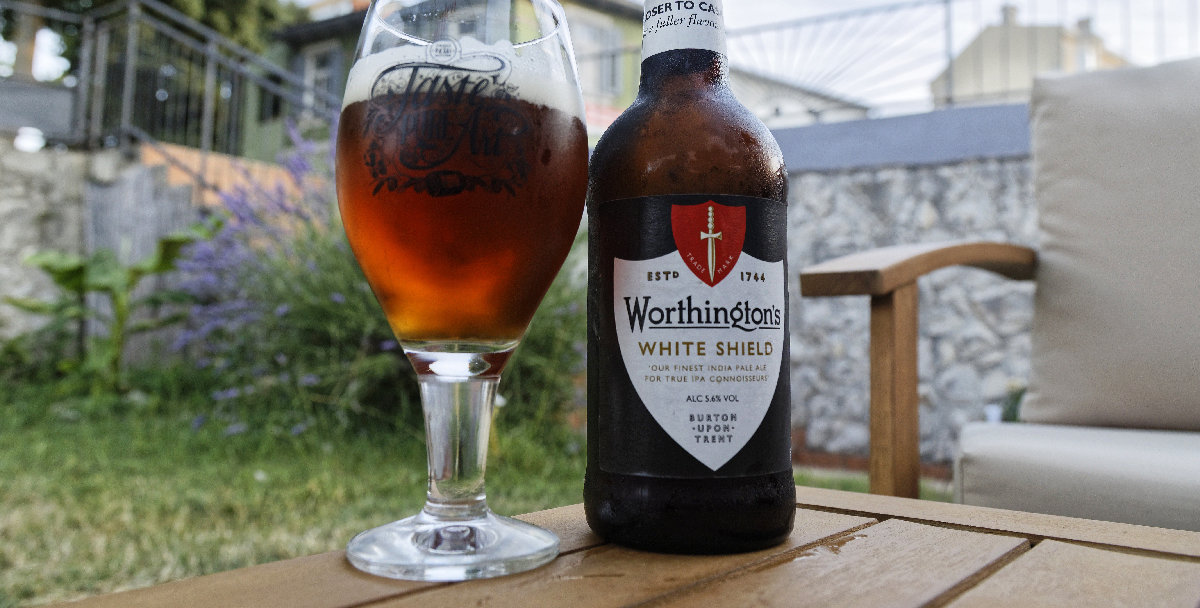
Burton or Burton Upon Trent to give it its full title may not the first place you think of when it comes to sourcing a holiday destination. However along with many of England’s older towns Burton has plenty to offer both from a historical viewpoint and amenity wise. Plus Burton has a bit of talent in beer making if you fancy a pint. Active since someone built a Roman road through it, the town is now the fourth largest in Staffordshire with 72,299 people living here at the time of the 2011 Census.
Given this, we just had to add it to our ever-growing list of Five Minutes Spare Town Guides, and not just because some of us like a beer!
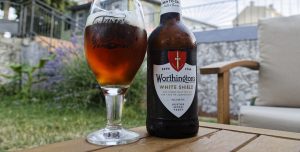
Image: burnel1/Shutterstock.com
So hang onto your hats, folks, because here comes Burton…
The Early Days of Burton
There are two different stories about the early days of Burton-upon-Trent. One has it that Bishop Wilfrid of York was gifted lands by the Christian king of Mercia, a man by the name of Wulfhere. Some of that land included lands along the River Trent, which is where we got Burton from. The Bishop built abbeys as good Bishops did, and the rest was history.
Our favoured version of the tale relies on travelling nuns passing through the area around 653 AD. Saint Modwen, an Irish Abbess, made her way on a pilgrimage to Rome. On her way, she stopped at an island in the River Trent and established an abbey, where she stayed for seven years. Later, she would return to the area, setting up another church at Mount Calvus on her way home again. She died in Dundee, at the ripe old age of 130 years old. She was removed to Burton abbey and buried there, where shrines are abundant and her symbol – the silver swan – is everywhere.
It is beautiful to think that, nearly six hundred years later, the abbot sent to Ireland for more information on the Abbess Modwen. It was then, in the 12th century, that she was named a saint. Relics of her time on this earth were kept at chapels up and down England for hundreds of years after her death.
Moving on with the history of Burton… in 1003, a Benedictine Abbey was added across the river, so now you had two abbeys in the same area. None of this stood them in good stead for the 15th century, when King Henry VIII shut them all down. Meantime, however, they flourished and brought the town with them. Just as Saint Modwen was interred in her own abbey, so too was the thegn who set up the Benedictine Abbey. There are a lot of ghosts in Burton.
The Doomsday Book
Almost a hundred years later, in the Domesday Survey conducted in 1086, the town is recorded as the Land of Burton (St Mary and St Modwen). It is noted as having only 9 households and is said to have therefore been quite small. However, you can see in the entry that this included 16 acres of meadows, 4 plough teams, 2 ploughlands, and two woodlands. The land made an annual income of 3 pounds and ten shillings… which was millions back then.
The next exciting time for Burton-upon-Trent came in 1322, when Thomas Plantagenet, Earl of Lancaster, took shelter here after incurring the wrath of his cousin… the King. King Henry III took great displeasure when the Scottish Robert the Bruce invaded the north of England. All lands were ravaged – but those held by his cousin, Thomas, were left untouched.
The King (rightly) surmised that something shady was going on, and invaded Tutbury castle with an army. The ensuing battle was named the Battle of Burton Bridge. Needless to say that the King won. He took Thomas and his 30,000 by surprise by flanking him using a little known fjord. You can read a fuller account here if you like battles.
As the Abbeys grew in importance to eventually become the highest income abbey in Staffordshire; the king finally saw fit to grant them a town charter. In 1200, Burton finally became a real town, capable of holding a market of its own. They also held four fairs a year, with the cattle trade being one of the biggest sources of wealth.
No More Abbeys
1539 saw the dissolution of the abbeys, leading to an immediate drop in fortunes for the town. In 1541 the Abbey was founded, dissolved in 45’, founded again by William Paget, then sold off when he died in 63’ and his family were found to be guilty of treasonous plots. In the 1700s a new church was built out of the stones of the old abbey, only to be torn down a handful of years later. It seems like the sight might be cursed by the bones of a saint.
In 1612, the last person to be burned at the stake for heresy in England was killed in Burton. His name was Edward Wightman. He was a radical Anabaptist… whatever that means? Later, 1643 would see further discontent in the town, when Charles I had to suppress a rebellion in the famous English Civil War. The town declared on the side of the Parliamentarians, then switched allegiance to the king, then back again. The Royalists eventually captured the town, so the nobles who were trying to hedge their bets, hedged the wrong way.
The Industrial Era in Burton
From the 18th century onward, most of England entered the Industrial Revolution. In 1712, Burton kicked off their own growth by the addition of a wharf. Beer had been brewed here since around James I times at the turn of the 16/17th century. This allowed the beer to be shipped all over the Baltic world. Prussia was a noted destination of Burton beer.
As of 1712, Burton beer was sold in London. This trade was only really halted for a little while during the Napoleonic Wars… several breweries had sprung up by then, and they negotiated the war by shipping via canals and supplying Britain with beer, instead. The Burton pale ale was well known in London by the time the Industrial era truly kicked in.
Brewing is in
By 1880, Burton had roughly 30 breweries. Between them, they were producing about a third of all beer consumed in the British Empire. The industry did experience a slump at the start of the 1900s due to the war, but it survived. There are still breweries in Burton that you can visit, sample, and enjoy.
Between 1789 and 1801 the town’s population rose by a full quarter. This led to severe congestion around 1850 since people were coming and going on narrow streets. This often resulted in slow market days and delays in the delivery of goods.
In the 1870s, St. Paul’s Square was built to take some of the strain from the high street. Around the same time, the local medical officer reported concern about overcrowding and cited the breweries as being to blame. The town was amply spread out, but the breweries weren’t providing housing for their workers.
It was this overcrowding that led to council housing in the early 1900s to alleviate some of the slums. Poor water supplies and sewerage systems were also mentioned by the same officer, who put the death rate due to poor living conditions at 25 people per thousand.
20th Century Burton
In 1900 the population stood at 50,000 people. Since wages were at a reported £2 a week for brewers, a union for their betterment was set up in 1911. Massive unemployment ensued as the breweries started to close down… and then WWI hit.
WWI in Burton would have seen some major changes. Hundreds of unemployed young men signed up to go and fight overseas with no prior warning of what they were getting themselves into. The Buddy Regiments saw many men from Burton die together, on the front lines.
WWII saw little difference in terms of men who died fighting – but the home front suffered at the hands of German bombers. The Bombing of the Breweries, as it came to be called, saw water tanks burst on at least one brewery. The cellars flooded; people were killed. The town itself was bombed too, but the horror was in the drownings.
Burton So Much More than a Brewery Town
Modern Burton-upon-Trent is a thriving, bustling town, with a population of just over 72,000 people. Though the wars took away many of the young men in Britain, enough of them made it back that family life could return to normal.
The 20th century saw the addition of streetlights, public parks, museums, shopping centres, and all the mod-cons you could expect out of 20th-century life. The breweries might not all have made it, but the ones that did now have a history almost as long as some towns. The people of Burton are staunch, proud, and strong as oxen. We hope they continue to make great beer long after we are all gone.
Fun Facts about Burton, England
Every town we tour in England seems to have some delightful hidden facts behind it. Burton-upon-Trent had more than a few hidden up its sleeve. We sought out the Five Minutes Spare favourite fun facts about Burton, just for you… enjoy!
- Burton is most famous as a beer-brewing town. Its contribution helped keep Industrial Britain drunk, and we can’t thank them enough!
- Although Burton was the sight of the famous crossing point that kept prompting battles; the fjord was completely impassable when the river was in spate. This could mean no entry or exit from the town in winter.
- While being transferred down to be held as a prisoner in Tutbury Castle, Mary Queen of Scots stayed at the Three Queens Hotel in town.
- Branston Pickle was so named after the factory Crosse And Blackwell bought on the outskirts of Burton. There’s nothing noteworthy about this, except that the factory used to make MACHINE GUNS. If you find part of a bullet in your pickle, that’s why!
- Since so many pre-war aviation meetings were held in Burton, they named one of the streets Aviation Lane.
Wow! We’re so impressed at the rich history of this place. We hope it is as interesting to read for you guys as it has been for us to find out about. Let’s move on to the Industrial Era in Burton, before we run out of paper.
Famous People from Burton, England
Now that we have finally waded through about two thousand years, let’s turn our attention to famous people from this area. Who do we know from Burton-upon-Trent? We’re pretty sure you will recognise more of the Five Minutes Spare favourite famous people from Burton than you think you do…
- Tom Weston-Jones – actor from the Warrior and other things.
- Alastair Yates, the News presenter, was born here.
- Several writers, including Jean Sprackland, Kathryn Stubbes, David Macaulay, and Patrick Considine.
- Several recipients of medals of bravery such as the VC.
- The magician Lucy Gallone is from Burton
There are several others, but these were the ones that piqued our interest. Burton has also been a key player in terms of war, having produced several key officers who helped stop us from getting invaded. Thanks, Burton, we owe you.
Best Bits of Burton
Now we get to the good part – what you do as a tourist in Burton. What attractions are there? Where can you find trouble? Let’s look more closely and find out…
Historic Sights and Landmarks
It almost goes without saying but some of the oldest buildings in Burton are breweries. You might be forgiven for thinking there aren’t many historic houses here… but once you consider the breweries the gap quickly closes. The Tower Brewery was established in 2001 – but on the site of an older brewery, which seems to be the way it works here. There’s the Burton Town Brewery too, and there’s also a tour of Marston’s Brewery because you can never have enough beer.
One of the other biggest landmarks in town is St George’s Park. This is the home of the National Football Association of Great Britain, so this is where the idea for the FA cup was birthed. You can’t miss it – especially not if you are there with a football fan.
Galleries and Museums
OK, so it’s not maybe for the kids, but you should pop into the National Brewery Centre while you are here. It gives you great insights into the history of the town’s economy, while simultaneously being a pleasant way to spend an afternoon. There are horse-drawn carriages, which we love, and it is such a popular place that it made it to be the top Burton attraction, according to trip advisor.
Next on the list of awesome museum-style attractions, comes the Claymills Victorian Pumping Station. This place is full of the magic of the steam engine, and regularly restores old industrial machinery to add to their excellent collection. This is one of the best museums in Burton-upon-Trent to visit when you have kids.
When it comes to galleries, the best known in town is Gallery 3. You can browse some fine art, or you can go online to their store and order yourself some fairly original, limited edition and collectable prints. They do a lot of superhero art, and we love it. We always appreciate a good Wonder-woman.
Outdoor Attractions
There is a Children’s Farm in Burton, but don’t panic – it’s a farm with children’s playsets in it… not an actual farm where they rounded up all the kids pied-piper style. It’s called the Churches Farm Anslow – Tea Rooms and Children’s Farm. With a name like that we imagine two old ladies, one of whom lives in a Gingerbread house.
There is actually a Falconry centre just outside of Burton. This location lets the little ones learn all about the birds of prey within and, with a little luck and easing of current restrictions, they might even be able to wear the gauntlet and hold a bird! It’s called the Hawksflight Falconry centre and you should definitely spend time there if you are in Burton for a holiday.
Locals love the nearby Branston Water Park, which allows you to take some lovely walks near the water. It was once a post-Industrial Revolution empty gravel pit, but now sports a filled nature reserve with beautiful ponds and even some boating. If you are interested in outdoor attractions, you should also drop by Stapenhill Gardens for another lovely walking location.
Sport In Burton
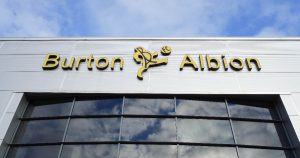
Image: Michael715/Shutterstock.com
Burton is home to Burton Albion Football Club and you can go and visit them, take the tour, or see a game…. depending on who you support. They play at the Pirelli Stadium on Princess Way in the heart of town.
Burton is also home to a rugby club. Burton RFC is a long-running town tradition with a rich and varied history. Head over to their page and have a browse if you are into it.
If not, then don’t panic… there are plenty of golf clubs at any point in Britain, so we got you. In fact, there are three within a stone’s throw from Burton upon Trent. Check out the Burton-on-Trent Golf Club, the Branston Golf & Country Club, or the Belmont Golf Course and Driving Range. Between the three, you are bound to find both a good course and a mate to play it with.
Shopping and Retail
There are a few places to shop in town. Asides from the busy main streets, you can probably find everything you are looking for at the Octagon, although sources say it has gone downhill a little in recent times. Check out the Burton Place Shopping Centre for an alternative.
Recreational Activities
We dare you to head over to Aqua Narrowboats, hire a new ride, and spend a few days on the water. Why not? It’s one of the nicest ways to see the English countryside. If that doesn’t interest you, there’s always the Red Carpet Cinema and Café Bar for something to do in the evening.
Other Notable Burton Attractions
As ever, there is more to this sunny town than meets the eye. Besides what we have already mentioned above, there are a hundred other things to see and do around town. Some of the best bits of Burton that we couldn’t fit in, include:
- In Hanbury, just south of town, you will find the Fauld crater. This happened in 1944 when an underground RAF base suffered a munitions explosion. Around 4000 tonnes of high explosive went off by accident, leading to one of the biggest ever explosions on British soil. You can visit the crater, whose presence is marked out in a humbling way and marked with a stone, to ensure we don’t repeat the same mistakes again.
- Cooper’s Square is yet a third option in shopping centres.
- There is a Marina out by Barton, so if boats are your thing, Burton is a great place to visit.
- There is a firm in town that offers Llama treks through the National Forest. You have been both informed and warned.
- Fradley Junction is just downstream and is known to be one of the busiest places on the English waterway system.
As you can see, the list of things to do in Burton-upon-Trent just grows and grows. If you want to visit it for your next holiday, book up, get excited, and if you can – rent out a boat.
How to get there?
We have reached that stage of the article again – when you now know all that we know about Burton-upon-Trent. But when we still haven’t told you how to get there.
By Road
If you follow the A38 south from Derby you will soon reach Burton-upon-Trent.
By Rail
You are heading for Burton-on-Trent station.
By Air
Your nearest airport is the East Midlands, which is about 13 miles away.
By Sea
That’s a big no, although if you have a canal boat you can pass through on the River Trent.
Got Five Minutes?
If you find yourself still searching aimlessly through internet pages, or if you are trying seriously to pick a good place for a staycation, then our pages are exactly what you need. Check out the travel guides on Five Minutes Spare and never be bored for something to read.
